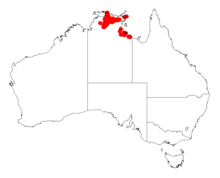| Acacia producta | |
|---|---|
| Scientific classification | |
| Kingdom: | Plantae |
| Clade: | Tracheophytes |
| Clade: | Angiosperms |
| Clade: | Eudicots |
| Clade: | Rosids |
| Order: | Fabales |
| Family: | Fabaceae |
| Subfamily: | Caesalpinioideae |
| Clade: | Mimosoid clade |
| Genus: | Acacia |
| Species: | A. producta
|
| Binomial name | |
| Acacia producta | |

| |
| Occurrence data from AVH | |
Acacia producta is a shrub of the genus Acacia and the subgenus Plurinerves that is endemic to northern central Australia.
Description[edit]
The resinous shrub typically grows to a height of about 2 m (6 ft 7 in) and has an erect or prostrate habit with smooth dark grey coloured bark and angular branchlets that have resin-crenulated ridges. Like most species of Acacia it has phyllodes rather than true leaves. The evergreen phyllodes have an elliptic to narrowly oblanceolate shape and are straight or slightly curved. The phyllodes have a length of 3 to 8 cm (1.2 to 3.1 in) and a width of 5 to 23 mm (0.20 to 0.91 in) and have three prominent longitudinal nerves.[1]
Taxonomy[edit]
The species was first formally described by the botanist Mary Tindale in 1980 as a part of the work Notes on Australian taxa of Acacia as apublished in the journal Telopea. It was reclassified in 2003 by Leslie Pedley as Racosperma productum then returned to genus Acacia in 2006.[2]
Distribution[edit]
It is native to the top end of the Northern Territory including Maria Island in the Gulf of Carpentaria where it is usually situated on rocky sandstone pavements on plateaux or alluvial flats where it is found growing in sandy or loamy or sandy-silty soils or over around laterite as a part of Eucalyptus woodland or in heathland communities.[1]
See also[edit]
References[edit]
- ^ a b "Acacia producta". World Wide Wattle. Western Australian Herbarium. Retrieved 29 December 2020.
- ^ "Acacia producta Tindale". Atlas of Living Australia. Global Biodiversity Information Facility. Retrieved 29 December 2020.